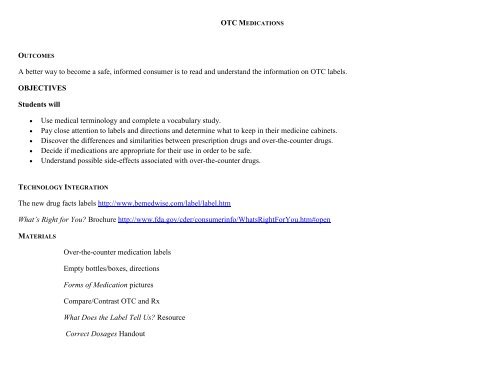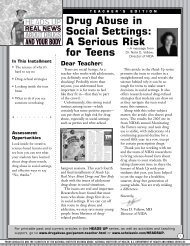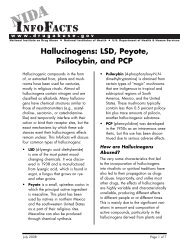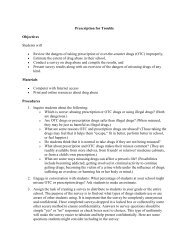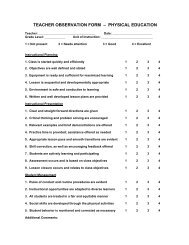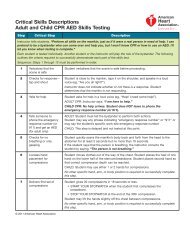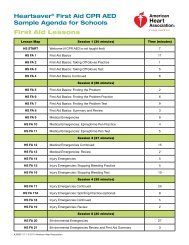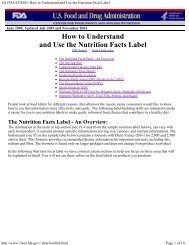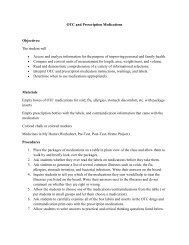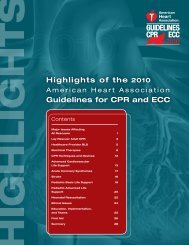Over the Counter Lesson Plan 2
Over the Counter Lesson Plan 2
Over the Counter Lesson Plan 2
Create successful ePaper yourself
Turn your PDF publications into a flip-book with our unique Google optimized e-Paper software.
<strong>Over</strong>-The-<strong>Counter</strong> Medications (OTC)http://www.<strong>the</strong>beehive.org/health/medicine_cabinet/over-<strong>the</strong>-counter-medications.aspWhat's <strong>Over</strong>-The-<strong>Counter</strong> Medication?You can walk into any drugstore or grocery store andbuy over-<strong>the</strong>-counter (OTC) medicines right off <strong>the</strong>shelf. Aspirin, cold medicine, and healing creams aresome common OTCs.You can take <strong>the</strong>se medicines for less seriousconditions, and <strong>the</strong>y're safe to use if you follow <strong>the</strong>directions carefully. There are usually lots ofdifferent types to choose from, so feel free to talk to<strong>the</strong> pharmacist about what you should buy, how totake <strong>the</strong> medication, or ask any o<strong>the</strong>r questions.Prescription drugs are usually stronger than over-<strong>the</strong>counterdrugs, so you need to be very careful taking<strong>the</strong>m. Prescriptions come with warning labels that tellyou what you need to watch out for, like taking <strong>the</strong>medicine with food or on an empty stomach, andpossible side effects, like sleeplessness, dizziness,drowsiness, rash, or headache.Prescriptions can be very expensive with or withou<strong>the</strong>alth insurance. If you have health insurance,Medicaid, or Medicare, your prescriptions will costless than without coverage. There are programsavailable to help you cover <strong>the</strong> costs of prescriptionmedications.What are some common OTCs?Before buying any OTCs, compare <strong>the</strong> ingredientslisted on <strong>the</strong> package. If <strong>the</strong> ingredients for brandnames and generics are <strong>the</strong> same, you can savemoney on <strong>the</strong> generics. Here's a list of some of <strong>the</strong>most common OTCs.• Pain relievers (Ibuprofen)• Fever Reducers (aspirin)• Stomach Soo<strong>the</strong>rs (Antacid, Pepto Bismol)• Antihistamines (for allergies)• Cough and Cold• Anti-itch (Calamine Lotion, Cortaid)• Laxatives (for constipation)• Anti-fungal (athlete's foot)• Yeast infection medicine• Sleep aids• Aids to stop smoking (Nicorette)Prescription Medications (Rx)http://www.<strong>the</strong>beehive.org/health/medicine_cabinet/prescription-medication.aspWhat is prescription medication?Prescription medication is medication available withpermission from a doctor. When you go to <strong>the</strong> doctorto find out what's making you sick, <strong>the</strong> doctor willidentify <strong>the</strong> best medication or drug for you to take.The doctor will write you a prescription, you take itto <strong>the</strong> drugstore or grocery store, and you can get itfilled.
COMPARE/CONTRAST OTC AND RX DRUGSDIRECTIONS: Using this Venn diagram, compare and contrast over-<strong>the</strong>-counterand prescription medications.
What Does <strong>the</strong> Label Tell Us? ResourceUnderstanding Labels and Instructionshttp://www.<strong>the</strong>beehive.org/health/medicine_cabinet/understanding-labels-and-instructions.aspBefore buying over-<strong>the</strong>-counter medication or taking prescription drugs, it's important that youknow how to read <strong>the</strong> instructions. It's also important to know if <strong>the</strong>re's something you're allergicto in <strong>the</strong> medication.Reading <strong>the</strong> label is <strong>the</strong> most important part of taking care of yourself or your family when usingover-<strong>the</strong>-counter (OTC) medicines. This is especially true because you probably take OTCmedicines without seeing a doctor first. Sometimes changes are made to <strong>the</strong> products you use all<strong>the</strong> time, so make sure you check <strong>the</strong> label.If you read <strong>the</strong> label and still have questions, talk to a pharmacist, doctor, or ano<strong>the</strong>r healthcareprofessional. Use <strong>the</strong> links below to get more information and step-by-step guidesAlways Read <strong>the</strong> Labelhttp://my.webmd.com/content/article/61/67580.htm?lastselectedguid=%7B5FE84E90-BC77-4056-A91C-9531713CA348%7DReading <strong>the</strong> product label is <strong>the</strong> most important part of taking care of yourself or your familywhen using over-<strong>the</strong>-counter (OTC) medicines (those that are available without a prescription).This is especially true because you probably take OTC medicines without first seeing a doctor.The OTC medicine label contains important, easy-to-read usage and safety information.An FDA regulation makes sure <strong>the</strong> labels on all OTC medicines (from a tube of fluoridetoothpaste to a bottle of cough syrup) have information listed in <strong>the</strong> same order; are arranged in asimple, eye-catching, consistent style; and may contain easy-to-understand words.If you read <strong>the</strong> OTC medicine label and still have questions about <strong>the</strong> product, talk to yourdoctor, pharmacist, or o<strong>the</strong>r healthcare professional.What's on <strong>the</strong> LabelAll nonprescription, over-<strong>the</strong>-counter (OTC) medicine labels have detailed usage and warninginformation so consumers can properly choose and use <strong>the</strong> products. You'll find this information:• Product Name.• Active Ingredient. Therapeutic substance in product; amount of active ingredient perunit.• Uses. Symptoms or diseases <strong>the</strong> product will treat or prevent.• Warnings. When not to use <strong>the</strong> product; conditions that may require advice from adoctor before taking <strong>the</strong> product; possible interactions or side effects; when to stop taking
<strong>the</strong> product and when to contact a doctor; if you are pregnant or breastfeeding, seekguidance from a health care professional; keep product out of children's reach.• Inactive Ingredients. Substances such as colors or flavors.• Purpose. Product action or category (such as antihistamine, antacid, or coughsuppressant.)• Directions. Specific age categories, how to take, how much, how often, and how long.• O<strong>the</strong>r Information. How to store <strong>the</strong> product properly, and required information aboutcertain ingredients (such as <strong>the</strong> amount of calcium, potassium, or sodium <strong>the</strong> productcontains)• The expiration date. When applicable (date after which you should not use <strong>the</strong>product).• Lot or batch code. (Manufacturer information to help identify <strong>the</strong> product).• Name and address of manufacturer, packer, or distributor.• Net quantity of contents. (How much of <strong>the</strong> product is in each package).• What to do if an overdose occurs.The manufacturers of OTC medicines sometimes make changes to <strong>the</strong>ir products or labeling(new ingredients, dosages, or warnings). Make sure to read <strong>the</strong> label each time you buy <strong>the</strong>product. Always look for special "flags" or "banners" on <strong>the</strong> front product label alerting you tosuch changes.Understand <strong>Over</strong>-<strong>the</strong>-<strong>Counter</strong> Drug LabelsWebMD Public Information with <strong>the</strong> FDAUse actual labels, such as this example, that include <strong>the</strong> following information:
CORRECT DOSAGES HANDOUTWarnings:Do not exceed recommended dosage because at higher doses, nervousness, dizziness, orsleeplessness may occur. If symptoms do not improve within se en days, or are accompanied bya high fever, consult a physician before continuing use. Do not take <strong>the</strong> preparation if you havehigh blood pressure, heart disease, diabetes, thyroid disease, or difficulty in urination due toenlargement of <strong>the</strong> prostate gland, except under <strong>the</strong> advice and supervision of a physician. In <strong>the</strong>case that you are pregnant or nursing a baby, seek <strong>the</strong> advice of a health professional beforeusing this product.Drug Interaction Precaution:Do not take this product if you are presently taking a prescription anti-hypertension or antidepressantdrug containing a monoamine oxidase inhibitor except under <strong>the</strong> advice andsupervision of a physician.KEEP THIS AND ALL MEDICATIONS OUT OF CHILDREN’S REACH.In case of accidental overdose, seek professional assistance or contact a Poison Control Centerimmediately.1. What might happen if you take too much of this medicine?2. Who should not use this medicine?3. What should you do in case of an overdose?
Teacher Notes on Drug InteractionsDiscuss <strong>the</strong> reasons we have medication and why we use it. Next, brainstorm <strong>the</strong> pros and consof following o<strong>the</strong>r actions and directions. Talk about <strong>the</strong> medical profession, its reliability andexpertise, and <strong>the</strong> government and its rules on <strong>the</strong> regulation of drugs. Students can also identifyany medications that <strong>the</strong>y know of that have been approved for use by <strong>the</strong> government and laterfound to be harmful to humans.Everyone needs to be an informed consumer. Discuss how students can become informed aboutmedications that <strong>the</strong>y may be taking. Examples may include: reading <strong>the</strong> warning labels orprescription information, discussing <strong>the</strong> pros and cons of a medicine with a doctor, researching<strong>the</strong> medication, etc. Have <strong>the</strong> students discuss <strong>the</strong> effects that medications may have on <strong>the</strong>m.Discuss <strong>the</strong> need for each student to become aware that <strong>the</strong>re are medications on <strong>the</strong> market thatmay be harmful and to find out what ones might be harmful for <strong>the</strong>m.Ask: Has anyone ever known someone who has had a reaction to an over <strong>the</strong> counter drug, suchas Tylenol, cough syrup, or vitamins? Does anyone have an allergy to something? Examplescould include reactions to bee stings, penicillin, different materials, etc. Discuss <strong>the</strong>consequences of reactions such as swelling, difficulty in breathing, etc. What can be done toprevent ano<strong>the</strong>r reaction or to inform o<strong>the</strong>rs of <strong>the</strong> possibility of a reaction? Examples mayinclude: medical records of allergies, medical cards in one’s billfold, a medallion worn on achain, etc.Higher Level Activity: Have students search for articles on medications that have severe sideeffects. Create a list of <strong>the</strong> different medications and a short synopsis of <strong>the</strong> side effects. Havestudents share with <strong>the</strong> class <strong>the</strong>ir findings and what <strong>the</strong> findings could mean to <strong>the</strong>m.ReferencesThe United States Food and Drug Administration websitewww.<strong>the</strong>beehive.org


